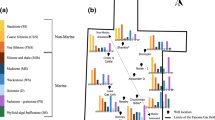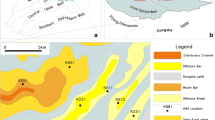Abstract
A Bakken formation learning network is established based upon type well-log data (seven petrophysical variables) and a discrete stratigraphic index (Str) comprising 1000 records extending into the underlying Three Forks formation. The transparent open box (TOB) learning network is applied to this dataset to predict Str, which it achieves with only two erroneous predictions for the 1000 records and high statistical accuracy (root mean squared error (RMSE) = 0.1057, for Str scale of 1–4; coefficient of determination (R2) = 0.9870). Data mining reveals that the few prediction errors are located in the transition zones between the stratigraphic members. Feature selection focused on those transition zones has the potential to further reduce errors. The TOB algorithm demonstrates its potential to be applied for more extensive and complex lithofacies and stratigraphic sequence modeling. The Bakken TOB network is also configured to predict shear wave velocity, which it does with high accuracy (RMSE = 11 m/s and R2 = 0.9994), highlighting the flexibility of the TOB algorithm to assess both continuous and discrete dependent variables.




Similar content being viewed by others
References
Altman, N. S. (1992). An introduction to kernel and nearest-neighbor nonparametric regression. The American Statistician,46(3), 175–185.
Arora, S., & Singh, S. (2013). The firefly optimization algorithm: Convergence analysis and parameter selection. International Journal of Computer Applications,69(3), 48–52.
Arora, S., & Singh, S. (2014). Performance research on firefly optimization algorithm with mutation. In International conference on communication, computing & systems (pp. 168–172).
Atkeson, C. G., Moore, A. W., & Schaal, S. (1997). Locally weighted learning. Artificial Intelligence Review,11(1–5), 11–73.
Bhattacharya, S., & Carr, T. (2016). Integrated petrofacies characterization and interpretation of depositional environment of the Bakken shale in the Williston basin, north America. Petrophysics,57(2), 95–110.
Bhattacharya, S., & Carr, T. (2019). Integrated data-driven 3D shale lithofacies modeling of the Bakken Formation in the Williston basin, North Dakota, United States. Journal of Petroleum Science and Engineering,177, 1072–1086.
Bhattacharya, S., & Mishra, S. (2018). Applications of machine learning for facies and fracture prediction using Bayesian Network Theory and Random Forest: Case studies from the Appalachian basin, USA. Journal of Petroleum Science and Engineering,170, 1005–1017.
Birattari, M., Bontempi, G., & Bersini, H. (1999). Lazy learning meets the recursive least squares algorithm. In Proceedings of the 1998 conference on advances in neural information processing systems II (pp. 375–381). Cambridge, MA: MIT Press.
Bontempi, G., Birattari, M., & Bersini, H. (1999). Lazy learning for local modeling and control design. International Journal of Control,72(7/8), 643–658.
Chemali, R., Gianzero, S., Strickland, R. W., & Tijani, S. M. (1983). The shoulder bed effect on the dual laterolog and its variation with the resistivity of the borehole fluid. In Society of petrophysicists and well-log analysts annual logging symposium, 27–30 June, Calgary, Alberta, 25 pp. https://www.onepetro.org/conference-paper/SPWLA-1983-UU.
Chen, G. H., & Shah, D. (2018). Explaining the success of nearest neighbor methods in prediction. Foundations and Trends in Machine Learning,10(5–6), 337–588.
Christopher, J. E. (1961). Transitional Devonian–Mississippian formations of southern Saskatchewan. Saskatchewan Department of Mineral Resources Report, 66, 103 pp.
Cover, T. M., & Hart, P. E. (1967). Nearest neighbor pattern classification. IEEE Transactions on Information Theory,13(1), 21–27.
Egenhoff, S. O., & Fishman, N. S. (2013). Traces in the dark—Sedimentary processes and facies gradients in the upper shale member of the Upper Devonian-Lower Mississippian Bakken Formation, Williston basin, North Dakota, USA. Journal of Sedimentary Research,83, 803–824.
EIA. (2019). Bakken Region Drilling productivity report, U. S. Energy Information Administration (EIA), March 2019. https://www.eia.gov/petroleum/drilling/pdf/bakken.pdf. Accessed April 12, 2019.
Fix, E., & Hodges, Jr. J. L. (1951). Discriminatory analysis, nonparametric discrimination: consistency properties. Technical report, USAF School of Aviation Medicine.
Flannery, J. (2006). Integrated analysis of the Bakken Petroleum System, U.S. Williston Basin. In Saskatchewan and Northern Plains Oil & Gas Symposium (pp. 138–145). Saskatchewan Geological Society.
Frontline Solvers. (2019). Standard excel solver—Limitations of nonlinear optimization. https://www.solver.com/standard-excel-solver-limitations-nonlinear-optimization Accessed April 12, 2019.
Garcia, S., Derrac, J., Cano, J., & Herrera, F. (2012). Prototype selection for nearest neighbor classification: Taxonomy and empirical study. IEEE Transactions on Pattern Analysis and Machine Intelligence,34(3), 417–435.
Gaswirth, S. B., Marra, K. R., Cook, T. A, Charpentier, R. R., Gautier, D. L., Higley, D. K., et al. (2013). Assessment of undiscovered oil resources in the Bakken and Three Forks Formations, Williston Basin Province, Montana, North Dakota, and South Dakota, 2013. U.S. Geological Survey Fact Sheet 2013–3013 (p. 4). https://pubs.usgs.gov/fs/2013/3013/.
Guedez, A., Mokhtari, M., Seibi, A., & Mitra, A. (2018). Developing correlations for velocity models in vertical transverse isotropic media: Bakken case study. Journal of Natural Gas Science and Engineering,54, 175–188.
Gul, A., Perperoglou, A., Khan, Z., Mahmoud, O., Miftahuddin, M., Adler, W., & Lausen, B. (2018). Ensemble of a subset of kNN classifiers. Advances in Data Analysis and Classification, 12(4), 827–840. https://doi.org/10.1007/s11634-015-0227-5.
Gutschick, R. C., Suttner, L. J., & Switek, M. J. (1962). Biostratigraphy of transitional Devonian–Mississippian Sappington formation of southwest Montana: Billings Geological Society. In 13th annual field conference and symposium (pp. 79–87).
Heinert, M. (2008). Artificial neural networks—How to open the black boxes. Application of Artificial Intelligence in Engineering Geodesy: AIEG,5, 42–62.
Hester, T., & Schmoker, J. (1985). Selected physical properties of the Bakken Formation, North Dakota and Montana Part of the Williston Basin. Department of the Interior, U.S. Geological Survey, Oil and Gas Investigations.
Hyndman, R. J., & Koehler, A. B. (2006). Another look at measures of forecast accuracy. International Journal of Forecasting,22(4), 679–688. https://doi.org/10.1016/j.ijforecast.2006.03.001.
Kasper, D. (1992). Stratigraphy and sedimentology of the Bakken Formation of west-central Saskatchewan: A preliminary report. In Summary of investigations 1992, Saskatchewan Geological Survey. Saskatchewan Energy and Mines, Miscellaneous Report 92-4.
Kokesh, F. P., & Blizzard, R. B. (1959). Geometrical factors in sonic logging. Geophysics,24(1), 64–76.
Lever, J., Krywinski, M., & Altman, N. (2016). Model selection and overfitting. Nature Methods,13, 703–704. https://doi.org/10.1038/nmeth.3968.
Luo, G., Tian, Y., Bychina, M., & Ehlig-Economides, C. (2018). Production optimization using machine learning in Bakken Shale. In URTEC-2902505-MS. SPE/AAPG/SEG unconventional resources technology conference, 23–25 July, Houston, Texas, USA, 24 pp. https://doi.org/10.15530/urtec-2018-2902505.
MacQueen, J. B. (1967). Some methods for classification and analysis of multivariate observations. In Proceedings of 5th Berkeley symposium on mathematical statistics and probability. 1 (pp. 281–297). University of California Press.
Makridakis, S. (1993). Accuracy measures: Theoretical and practical concerns. International Journal of Forecasting,9(4), 527–529.
Mood, A., Graybill, F., & Boes, D. (1974). Introduction to the theory of statistics (3rd ed.). New York: McGraw-Hill.
Nordquist, J. W. (1953). Mississippian stratigraphy of northern Montana. In Fourth annual field conference guidebook (pp. 68–82). Billings Geological Society.
North Dakota Industrial Commission. (2017). Department of Mineral Resources. Oil gas division. https://www.dmr.nd.gov/oilgas. Accessed April 12, 2019.
Pal, S. K., Raj, C. S., & Singh, A. P. (2012). Comparative study of firefly algorithm and particle swarm optimization for noisy non-linear optimization problems. International Journal of Intelligent Systems and Applications,10, 50–57.
Panja, P., Velasco, R., Pathak, M., & Deo, M. (2018). Application of artificial intelligence to forecast hydrocarbon production from shale. Petroleum,4, 75–89.
Parapuram, G. K., Mokhtari, M., & Hmida, J. B. (2017). Prediction and analysis of geomechanical properties of the upper Bakken shale utilizing artificial intelligence and data mining. In Unconventional resources technology conference, 24–26 July, Austin, Texas, USA.
Parapuram, G. K., Mokhtari, M., & Hmida, J. B. (2018). An artificially intelligent technique to generate synthetic geomechanical well logs for the Bakken Formation. Energies,11, 680. https://doi.org/10.3390/en11030680.
Pearson, K. (1894). On the dissection of asymmetrical frequency curves. Philosophical Transactions of the Royal Society A,185, 71–110.
Pitman, J. K., Price, L. C., & LeFever, J. A. (2001). Diagenesis and fracture development in the Bakken Formation, Williston Basin: implications for reservoir quality in the middle member (pp. 1–19). U.S. Geological Survey Professional Paper, 1653.
Pollastro, R., Roberts, L., Cook, T., & Lewan, M. (2008). Assessment of undiscovered technically recoverable oil and gas resources of the Bakken Formation, Williston Basin, Montana and North Dakota. U.S. Geological Survey Open-File Report 2008–1353 (3 pp).
Samworth, R. (2012). Optimal weighted nearest neighbour classifiers. The Annals of Statistics,40(5), 2733–2763.
Shakhnarovich, G., Darrell, T., & Indyk P. (2006). Nearest-neighbor methods in learning and vision: theory and practice (Neural information processing). The MIT Press. ISBN: 026219547X.
Simpson, G., Hohman, J., Pitie, I., & Horkowitz, J. (2015). Using advanced logging measurements to develop a robust petrophysical model for the Bakken petroleum system. In SPWLA 56th annual logging symposium, July 18–22 (pp. 1–24).
Smith, M. G., & Bustin, R. M. (1996). Lithofacies and paleoenvironments of the Late Devonian and Early Mississippian Bakken Formation. Williston Basin: Canadian Society of Petroleum Geologists Bulletin,44, 495–507.
Sonnenberg, S. A. (2017). Sequence stratigraphy of the Bakken and Three Forks Formations, Williston Basin, USA. Presented at: AAPG Rocky Mountain section annual meeting, Billings, Montana, June 25–28.
Wood, D. A. (2016a). Metaheuristic profiling to assess performance of hybrid evolutionary optimization algorithms applied to complex wellbore trajectories. Journal of Natural Gas Science and Engineering,33, 751–768. https://doi.org/10.1016/j.jngse.2016.05.041.
Wood, D. A. (2016b). Evolutionary memetic algorithms supported by metaheuristic profiling effectively applied to the optimization of discrete routing problems. Journal of Natural Gas Science and Engineering,35, 997–1014. https://doi.org/10.1016/j.jngse.2016.09.031.
Wood, D. A. (2018a). A transparent open-box learning network provides insight to complex systems and a performance benchmark for more-opaque machine learning algorithms. Advances in Geo-Energy Research,2(2), 148–162.
Wood, D. A. (2018b). Transparent open-box learning network provides auditable predictions for coal gross calorific value. Modeling Earth Systems and Environment. https://doi.org/10.1007/s40808-018-0543-9.
Wood, D. A. (2019). Sensitivity analysis and optimization capabilities of the transparent open-box learning network in predicting coal gross calorific value from underlying compositional variables. Modeling Earth Systems and Environment. https://doi.org/10.1007/s40808-019-00583-1.
Wood, D. A., Choubineh, A., & Vaferi, B. (2018). Transparent open-box learning network provides auditable predictions: Pool boiling heat transfer coefficient for alumina-water-based nanofluids. Journal of Thermal Analysis and Calorimetry. https://doi.org/10.1007/s10973-018-7722-9.
Wright, S. (1921). Correlation and causation. Journal of Agricultural Research,20, 557–585.
Yang, X.-S. (2009). Firefly algorithms for multimodal optimization. In Stochastic Algorithms: Foundations and Applications, SAGA, Lecture Notes in Computer Sciences (Vol. 5792, pp. 169–178).
Yang, X.-S., & He, X. (2013). Firefly algorithm: Recent advances and applications. International Journal of Swarm Intelligence,1(1), 36–50.
Funding
This research did not receive any specific grant from funding agencies in the public, commercial, or not-for-profit sectors.
Author information
Authors and Affiliations
Corresponding author
Ethics declarations
Conflict of interest
The author declares no conflicts of interest related to the topics addressed in this study.
Electronic supplementary material
Below is the link to the electronic supplementary material.
Appendices
Appendix 1
Schematic workflow diagram for the TOB well-log learning methodology.

Appendix 2
The reconstructed stratigraphic member and Bakken type well-log dataset analyzed in this study (including selected ratios between the variables) are included as a supplementary Excel file.
Rights and permissions
About this article
Cite this article
Wood, D.A. Bakken Stratigraphic and Type Well-Log Learning Network for Transparent Prediction and Rigorous Data Mining. Nat Resour Res 29, 1329–1349 (2020). https://doi.org/10.1007/s11053-019-09525-1
Received:
Accepted:
Published:
Issue Date:
DOI: https://doi.org/10.1007/s11053-019-09525-1




